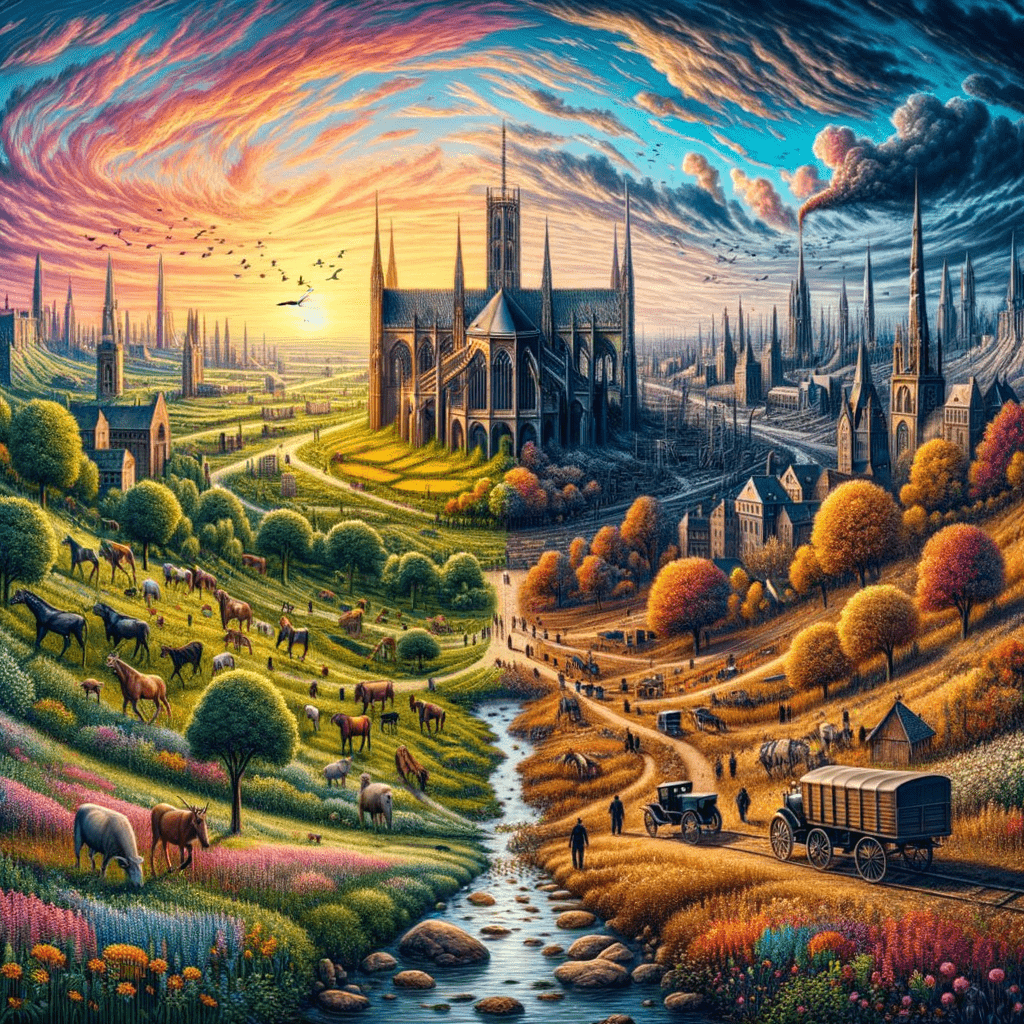Analyze how the concept of landscape in European art evolved in the 19th century, reflecting the technological and cultural changes of the era.
The 19th century was a period of great technological, cultural, and social changes in Europe. These changes had a significant impact on various aspects of life, including art. The concept of landscape in European art evolved considerably during this century, reflecting the transformations in society and technology. This article will explore how landscapes were represented in 19th-century European art, analyzing the factors that influenced this evolution.
The Romantic Movement and the Sublime Nature
At the beginning of the 19th century, the Romantic movement had a significant influence on European art. Romantic artists were fascinated by nature and sought to capture its beauty and power. Nature was seen as sublime, a concept that emphasized its grandeur and its capacity to evoke intense emotions. Artists like Caspar David Friedrich and J.M.W. Turner created works that portrayed majestic and dramatic landscapes.
Caspar David Friedrich: Known for his depictions of solitary and mysterious landscapes, such as “The Wanderer above the Sea of Fog”.
J.M.W. Turner: Famous for his paintings of storms and turbulent seas, such as “The Slave Ship”.
Realism and the Representation of Everyday Life
In the mid-19th century, the Realist movement began to gain popularity. Realist artists sought to depict everyday life accurately and in detail. The landscape was no longer seen merely as a backdrop for dramatic scenes but as a subject worthy of representation in its own right. Artists like Gustave Courbet and Jean-François Millet created works that depicted rural landscapes and scenes of peasant life.
Gustave Courbet: Known for his realistic paintings of landscapes and everyday life scenes, such as “The Painter’s Studio”.
Jean-François Millet: Famous for his depictions of peasant life, such as “The Angelus”.
Impressionism and Natural Light
Towards the end of the 19th century, the Impressionist movement revolutionized the way landscapes were depicted in European art. The Impressionists were interested in capturing the effects of natural light and atmospheric changes. Using quick brushstrokes and vivid colors, Impressionist artists aimed to capture the visual impression of a specific moment. Claude Monet, Pierre-Auguste Renoir, and Camille Pissarro are some of the most well-known artists of this movement.
Claude Monet: Famous for his series of paintings that capture the same scene under different lighting conditions, such as “Water Lilies”.
Pierre-Auguste Renoir: Known for his bright and colorful landscape paintings, such as “La Grenouillère”.
Camille Pissarro: Known for his depictions of rural and urban landscapes, such as “Boulevard Montmartre”.
Post-Impressionism and Stylistic Experimentation
The Post-Impressionism followed Impressionism and brought further innovations in the representation of landscapes. Post-Impressionist artists experimented with new techniques and styles, trying to express emotions and ideas through color and form. Vincent van Gogh, Paul Cézanne, and Georges Seurat are some of the artists who contributed to this movement.
Vincent van Gogh: Known for his vibrant and emotive landscapes, such as “Starry Night”.
Paul Cézanne: Famous for his depictions of mountains and landscapes, such as “Mont Sainte-Victoire”.
Georges Seurat: Known for his technique of pointillism, as seen in “A Sunday Afternoon on the Island of La Grande Jatte”.
The Role of Technology in the Transformation of the Landscape
The technological advancements of the 19th century had a significant impact on the representation of landscapes in art. The invention of photography allowed artists to capture images of nature with unprecedented accuracy. This influenced how landscapes were represented, leading to greater attention to detail and composition.
Additionally, the development of railways and infrastructure made it easier for artists to travel and explore new landscapes. This led to greater diversity in landscape representations, with artists painting scenes of distant and exotic places.
Urban Landscape and Industrialization
Industrialization transformed not only the natural landscape but also the urban one. European cities grew rapidly during the 19th century, and this change was reflected in art. Artists like Gustave Caillebotte and Camille Pissarro depicted urban scenes, capturing the energy and dynamism of modern cities.
Gustave Caillebotte: Known for his paintings of urban scenes, such as “Paris Street; Rainy Day”.
Camille Pissarro: Famous for his depictions of urban streets and squares, such as “Boulevard Montmartre at Night.”
Conclusion
In conclusion, the depiction of landscape in 19th-century European art was profoundly influenced by the technological and cultural changes of the time. From Romanticism to Realism, from Impressionism to Post-Impressionism, each artistic movement brought new perspectives and techniques to landscape representation. Artists responded to societal and technological changes, creating works that reflected their experiences and visions of the world.
The landscape became a central subject in European art of the 19th century, offering artists a way to explore and express their ideas and emotions. This period of transformation left a lasting legacy in art, influencing subsequent generations of artists and continuing to inspire today’s audience.
For further exploration of the topic, we recommend visiting the website of the Musée d’Orsay, which houses an extensive collection of 19th-century artworks.




